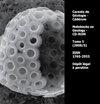Hiatuses and redeposits in the Tithonian-Berriasian transition at Le Chouet (Les Près, La Drôme, SE France): Sedimentological and biostratigraphical implications
IF 1.5
4区 地球科学
Q2 GEOLOGY
引用次数: 3
Abstract
Our new study of the Tithonian and lower Berriasian succession of Le Chouet (Les Près, La Drôme, France) better characterizes the lithological succession, the macro- and microfacies, and the stratigraphic ranges of some microfossils mostly calibrated on the calpionellid biozonation. On the lithological side, the Tithonian strata are dominantly characterized by thick-bedded breccias representing debris flows and related calciturbidites whereas the Berriasian strata are typically white limestones that also comprises scattered intercalations of thin-bedded breccias and calciturbitides (including cryptic mud calciturbidites). In thin sections, these white limestones display mud- to wackestone textures and their allochems are mostly tiny bioclasts (e.g., radiolarians, calpionellids, saccocomids). Breccias are lithoclastic rudstones and/or floatstones with a matrix similar to the calciturbidites. Their lithoclasts are either extraclasts sensu stricto (i.e., material derived from updip shallow-water areas) or pseudointraclasts, representing reworked subautochthonous material (i.e., mud- and wackestone lithoclasts with radiolarians, saccocomids and/or calpionellids). In addition to the erosional features observed at the bases of the gravity flows, these pseudointraclasts document the intensity of submarine erosion. Locally they help to estimate the depths of erosion updip of the deposit. A number of bioclasts are reworked from updip shallow-water areas; among them, it is worth mentioning the foraminifer Protopeneroplis ultragranulata (Gorbatchik), the first occurrence of which is dated to late early Tithonian. Saccocomids are part of the dominating pelagic biota reported from the lower and lower upper Tithonian interval whereas calpionellids replace them in the uppermost Tithonian to lower Berriasian interval. Intervals with saccocomids characteristic of zones 4-5 and zones 6-7 are respectively ascribed here to the lower Tithonian (4-5) and pro parte to the upper Tithonian (6-7). The biozonation of the calpionellid group sensu lato allows identification of the Boneti Subzone of the chitinoidellids, the Crassicollaria Zone with its four subzones (A0-A3), and the Alpina Zone with its first subzone (B1). On the basis of biostratigraphical and sedimentological data (including the rates of sedimentation), most zonal boundaries are located at the erosional bases of breccia or turbidite layers and thus coincide with hiatuses.Le Chouet (Les pr, La Drôme,法国东南部)梯东—berriasian过渡期的裂孔和再沉积:沉积学和生物地层意义
我们对Le Chouet (Les pr, La Drôme, France)的梯东纪和下Berriasian序列的新研究,更好地表征了一些微化石的岩性序列、宏微相和地层范围,这些微化石大多以calpionellid生物分带为标准。在岩性方面,梯统地层主要以厚层状角砾岩为特征,代表泥石流和相关的钙质积岩,而贝里亚地层则以典型的白色灰岩为特征,其中还包括薄层状角砾岩和钙质积岩(包括隐泥钙质积岩)的零散夹层。在薄片上,这些白色石灰石显示出泥质至微晶岩的纹理,它们的同种化学物大多是微小的生物碎屑(例如放射虫、calpionellid、saccocomids)。角砾岩是一种岩屑岩和(或)浮石,其基质类似于钙郁积岩。它们的岩屑要么是严格意义上的提取物(即来自上倾浅水区的物质),要么是假内碎屑,代表了改造过的亚原生物质(即含放射虫、糖虫和/或calpionelliids的泥质和碎屑岩)。除了在重力流底部观察到的侵蚀特征外,这些假内碎屑还记录了海底侵蚀的强度。在局部,它们有助于估计沉积物上倾的侵蚀深度。大量生物碎屑来自上倾浅水区;其中值得一提的是有孔虫Protopeneroplis ultragranulata (Gorbatchik),其最早出现时间可追溯到早泰东世晚期。据报道,糖科纲是下梯统和下梯统的主要上层生物群的一部分,而calpionellid在上梯统至下贝里亚梯统取代了糖科纲。4-5带和6-7带具有糖虫特征的层段分别属于下梯统(4-5),部分属于上梯统(6-7)。根据calpionelides类群的生物分带,可以划分为几丁质的Boneti亚带、带4个亚带(A0-A3)的crassiccollaria带和带1个亚带(B1)的Alpina带。根据生物地层学和沉积学资料(包括沉积速率),大多数地带性界线位于角砾岩或浊积岩的侵蚀基底,因此与裂谷重合。
本文章由计算机程序翻译,如有差异,请以英文原文为准。
求助全文
约1分钟内获得全文
求助全文
来源期刊

Carnets De Geologie
Earth and Planetary Sciences-Geology
CiteScore
2.90
自引率
14.30%
发文量
21
审稿时长
>12 weeks
期刊介绍:
Information not localized
 求助内容:
求助内容: 应助结果提醒方式:
应助结果提醒方式:


